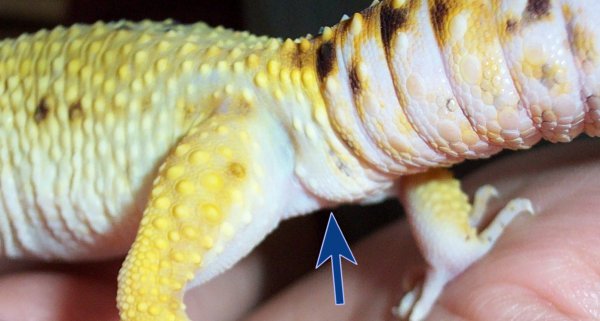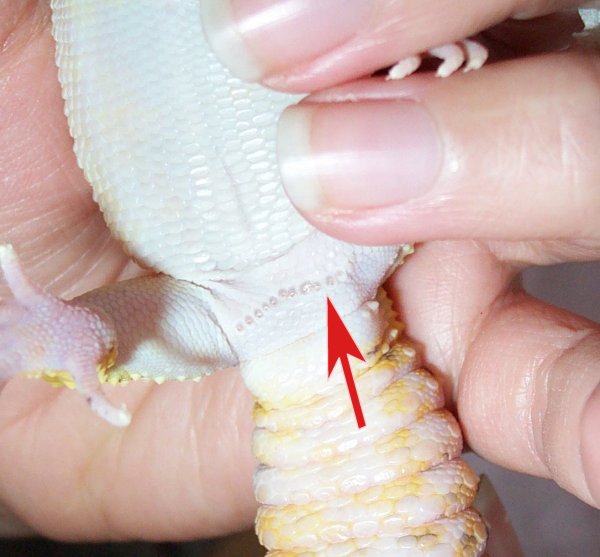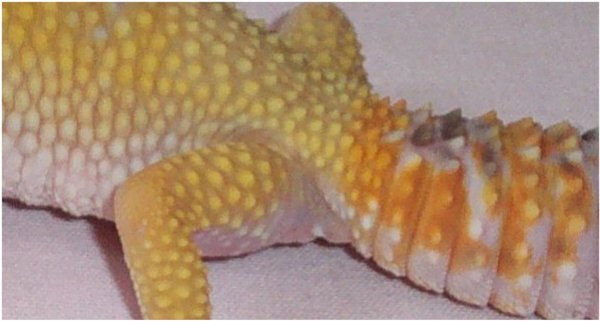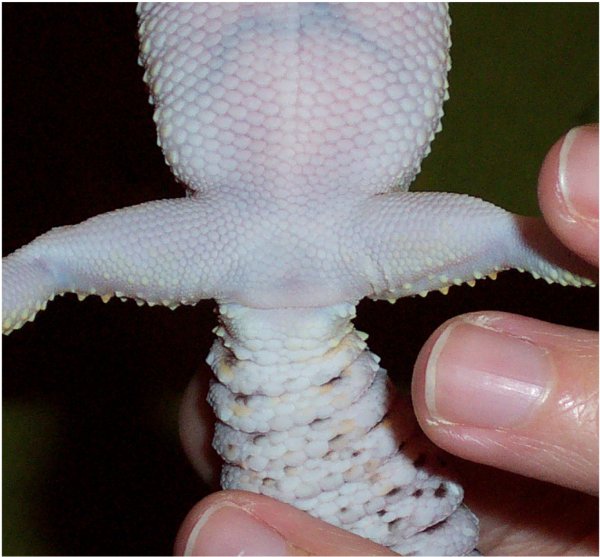Breeding Leopard Geckos
This page provides information regarding the breeding of leopard geckos. This information is the result of knowledge I have gained through experience of breeding leopard geckos for several years, plus reading other care sheets, books and discussions on various web forums. This information represents what I have personally found useful and interesting.
Background
Leopard geckos are relatively easy to breed and when in prime condition the females can produce many clutches of eggs during one breeding season. Most leopard gecko owners will at some point consider breeding their leopard geckos. Incubating and hatching baby leopard geckos is very rewarding and exciting, however, before you decide to breed your leopard geckos you should carefully consider, and be able to answer yes to, all of the following questions.
|
Prebreeding ConditionBreeding takes more of a toll on the female, therefore prior to breeding her you should ensure that she:
Males can breed from around 9 months. They should obviously be in perfect health, to avoid passing disease to the female. |
*Although I have recommended 50g as a minimum weight for the female to be before breeding, this is just a guide. In my opinion it is a better idea to wait until they have reached their full adult length. Some females get quite large, 9 inches and 80+g, and it is probably not a good idea to breed such a female when she's only 50g, that's only half her adult size. The best method is to weigh/measure your leos monthly or more, and once you're sure your leo is reaching its adult size/weight (i.e. when the weight and length gain starts to significantly slow) then you can consider breeding her.
Obviously before you breed your leopard geckos you will have established that you do have a pair of leopard geckos. Below are photos of a male and a female with a description of the characteristics of each.
|
|
Above: Photos of a male
|
Above: Photos of a female
|
Leopard geckos can be sexed accurately from the age of 2-3 weeks by those that are very experienced, however, for the rest of us patience is required. It is difficult to specify an age at which the sex of a leopard becomes obvious, some leopard geckos grow quicker than others.... once developed, males are very obvious and can easily be identified at 5-6 weeks old, however, some males do develop later, the main problem is defining the cut-off... when can you assume the gecko is definitely female? I would say, to be totally sure, you should wait until the gecko is 5-6 months old- if there are no signs of male-ness then you probably have a female!
Breeding Season
Breeding normally begins around spring time when the air temperatures and day length increase. Seasons vary in start time and length from season to season depending on temperature levels, however, breeding normally commences anywhere from January to March and can carry on until September.
Opposite: Buck (the
male) licks his lips to test the air after detecting Spooks' (the female)
scent
To cool or notCooling is the term used to describe the process of simulating winter conditions. Some breeders routinely cool their leopard geckos prior to the breeding season, however it is not necessary, leopard geckos will breed normally without being cooled. If you decide to cool your leopard geckos, you must first ensure that they are in a suitable condition to be cooled. Obviously, if you are intending to breed them, you should already be sure that they are in good condition (they should be at least 1 year old, fully grown, healthy with good fat reserves). Cooling is most commonly started in November or December. To simulate winter, the temperature, the amount of light and the amount of food need to be reduced. It is important that all of these changes are made gradually to ensure that your gecko has time to prepare physiologically. Normally the temperature of the substrate at the warm end of the tank should be around 88 F, during cooling this can be dropped by 2-3 F every 3-4 days to a final temperature of around 65 F. The temperature can remain at 65 F for around 3 weeks. The day light cycle is best handled using a timer, and it is easiest to follow the natural day/night cycle, that is, set the timer to switch on at sun rise and switch off at sun set. This way, the light cycle will be changing very gradually throughout the year. The amount of food offered and the frequency of feeding should also be reduced appropriately. This is difficult to quantify, as leopard geckos may behave differently. For this you should follow your instinct and only feed the leopard gecko when you see it out looking for food. At low temperatures leopard geckos are unable to digest their food properly and will often resort to regurgitating it instead. During cooling, leopard geckos are very sluggish, and will sleep for days, even weeks in a dark hide. The term for this state is "brumation", it is the reptile equivalent of hibernation. At the beginning of January, the temperature should be slowly increased again to 88 F and the frequency of feeding and amount of food should also be increased gradually. Opposite: Buck (the male) takes a closer look
at Spooks' (the female) |
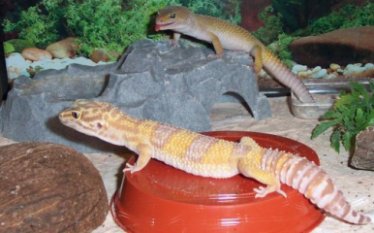 Breeders - keep together or separately?Q. Should the male and female be kept together in the same tank all year round, or should they only be introduced at breeding season? A. There is no definitive answer to this. It is dependent on each individual and then the owners preference. All leopard geckos have different personalities. Most are very tolerant of tank mates (obviously with the exception of more than 1 male per tank), however, some leopard geckos are not so tolerant of others. With respect to breeding, some males are very persistent and will continually pester the female, this can obviously stress the female and be detrimental to her health, or could lead to the male or female being injured. If you decide to keep your male and female(s) together, you should be very vigilant for problems (such as bullying, stress, injuries etc). In addition, if you are keeping a breeding group, you should also be aware that some of the females may not tolerate each other. The alternative is to keep your male and female(s) separate all year round, only introducing them for mating during the breeding season- this method has many advantages (you can be sure when they mated, monitor each of the geckos more closely and you also lessen the risk of injury/bullying). The female only needs to mate once to produce fertile eggs all season (they can store the sperm). 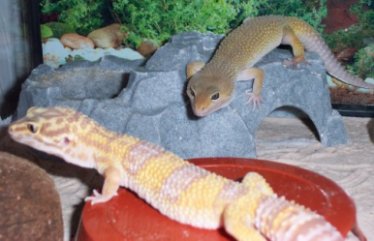 |
Mating
As shown in the photos above, the male can recognise the female by her scent.
When he detects the scent of a female in the air, he will move towards her.
Next, it is normal for the male to vibrate his tail very fast (it vibrates
so fast it makes a buzzing noise). If the female is not interested she may
either stand high on all 4 legs, and hold her tail high in the air, moving
it from side to side very slowly, attack him, or she run from him (if she
is not interested, 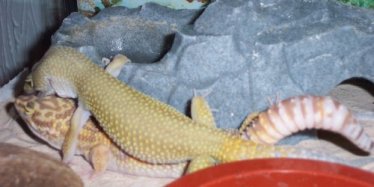 it
is best to remove the male from the tank to prevent fighting and injury).
it
is best to remove the male from the tank to prevent fighting and injury).
Breeding normally begins around spring time when the air temperatures and day length increase. Seasons vary in start time and length from season to season depending on temperature levels, however, breeding normally commences anywhere from January to March and can carry on until September.
Opposite: Buck (the male) and Spooks matin
Producing Eggs
Sometimes the females may have started to develop eggs prior to mating, sometimes they start to produce eggs once they have mated. This is dependent on the individual female and on temperature (i.e. if they think it is spring). This is one of the reasons that the time from mating to egg laying can vary. Normally, the female will lay her eggs anywhere from 2-5 weeks after mating. Developing eggs can normally be seen through the skin of the female's stomach and as the eggs get bigger she will become noticably bulky around her stomach. During this time, the behaviour of the female may also change, normally they become very inactive, spending alot of time lying at the warm end of the vivarium. Producing eggs requires alot of energy and an increased amount of calcium, therefore it is important to increase the amount of food and also to ensure that all food is dusted with calcium. Personally, I think it is a good idea to keep a calcium dish, containing calcium only powder in the viv all year round, however if you don't do this, it's certainly a good idea to at least add one during the breeding season. You should also ensure that the female has access to a good laying box (usually the humid hide can double up as a suitable egg laying site). The laying box should be a reasonable length (say 8 inches in length) with around 3-4 inches of moist substrate (vermiculite or ecoearth as suitable) in it. |
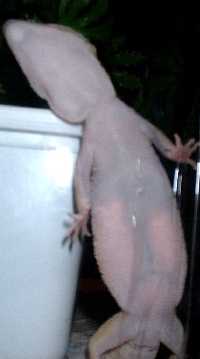
Eggs visible through the female's stomach |
Egg Laying
As mentioned above, the normal time from mating to laying eggs is can be anything from 2-5 weeks (during this time you should ensure that you have everything necessary for egg incubation). Prior to laying, the female may stop eating for up to a week. She may also start digging (sometimes all round the tank) a few days before laying (possibly checking for a good laying site), this behaviour is more common in first time females.
Normally, the female will choose to lay her eggs in the laying box you have provided (but sometimes she will lay them directly on the sand, or in the water bowl, some of these eggs can be rescued, but for most it is too late by the time they are found. The female will normally want to wait for some peace and quiet to lay her eggs, so it's best not to disturb her at this time. She will enter the laying box, dig a hole (or several holes!) then lay her eggs and cover them over again.
Eggs are laid in clutches, normally consisting of 2 eggs, although first time females or older female may lay single eggs. Females in their first season often do not get the egg recipe quite right, so their eggs often do not incubate well. Having said that some first time breeding females lay many eggs that, if incubated properly, go on to hatch.
Again, the time between clutches is variable, depending on the female (and her age). Anything from 10-35 days between clutches can be normal. First time females (and older females) may lay just 1 or 2 clutches, however, more experienced breeders may lay up to 10 (sometimes more) clutches of eggs in one season.
After laying her eggs, the female is likely to be very hungry and will eat a lot of food. It is important to ensure she gets enough food and calcium to help produce her next clutch of eggs which will probably already have started to develop.
Incubation
So, now the female has laid her eggs, the rest is up to you!!.. Good luck!!!! You will need an incubator (which ideally should have been set up and running at the correct temperature and humidity before the eggs arrive), some incubation medium (vermiculite, perlite or ecoearth are commonly used) and some incubation containers. The most commonly bought incubator is a hovabator, which can be bought from www.livefood.co.uk. Alternatively, you can make an incubator (link to be added). |
Incubation TemperatureLike most other reptiles, the incubation temperature determines whether the babies are males or females
Incubation temperatures above 90 F are thought to produce "hot females" which are normally quite aggressive and will not mate. |
The eggs should be incubated inside tubs (small tuperware tubs are ideal) inside the incubator. The tubs should be filled with just-damp incubating medium (add water to the medium until it forms a ball when squeezed, it should, however, not be so wet that water drips out when the medium is squeezed). The incubation medium should be gently packed into the incubation container, and it is useful to make a small thumb print where you are intending to place the eggs (to prevent the eggs from rolling). I have found that it is best to have loose fitting lids on the containers, this helps keep the humidity inside the container and prevents the babies getting loose in the incubator when they hatch. Tight-fitting lids, I have found, increase the humidity too much inside the incubation container and can fill quickly with condensation which can drip on the eggs, and even form pools of water in the bottom of the incubating container leading to failure of the eggs. If no lids are placed on the containers, the air tends to get too dry and the eggs dehydrate. The issue of lids may vary for different styles of incubator, but this is the method that works for me.
 The
eggs should be removed very carefully from the laying box, it is best to
touch them very lightly, or retrieve them using a spoon. The embryo will
have attached somewhere inside the top of the egg, therefore, you should
be very careful not to rotate the eggs, it is best if they are kept in exactly
the same position as they were laid in to avoid suffocating the embryo.
The
eggs should be removed very carefully from the laying box, it is best to
touch them very lightly, or retrieve them using a spoon. The embryo will
have attached somewhere inside the top of the egg, therefore, you should
be very careful not to rotate the eggs, it is best if they are kept in exactly
the same position as they were laid in to avoid suffocating the embryo.
It is normally possible to tell immediately if the eggs are fertile by candling them. This is very interesting, however, I would still advise to handle the eggs as little as possible to reduce the chance of any accidental damage. To candle the eggs, they can be kept in the incubation container. In a dark room shine a maglight torch into one end of the egg. If the egg is fertile, you would expect to see a bullseye shape ring of veins somewhere near the top. During development you can see the network of veins spreading throughout the egg, and during candling the egg will glow pink (infertile eggs will glow a yellow colour). As the embryo reaches full size it becomes more difficult to see any detail in the egg, sometimes all that is visible is a dark area and a big airspace near the top of the egg.
If you have your incubation conditions correct, fertile eggs will stay nice and white and will grow in size during incubation. Incorrect incubation conditions can obviously cause problems. If the temperature and/or humidity are too high/low it is likely that the egg will fail. Signs of failure during incubation are dents (which can be corrected by adding some damp moss on top of the egg) and mould (which can be gently wiped off using a cotton bud/q-tip). However, if the eggs are infertile, no amount of "correction" will help- sometimes, infertile eggs can incubate for months (although candling would obviously show them to be infertile).
Hatching and Hatchling Care
Follow the link

